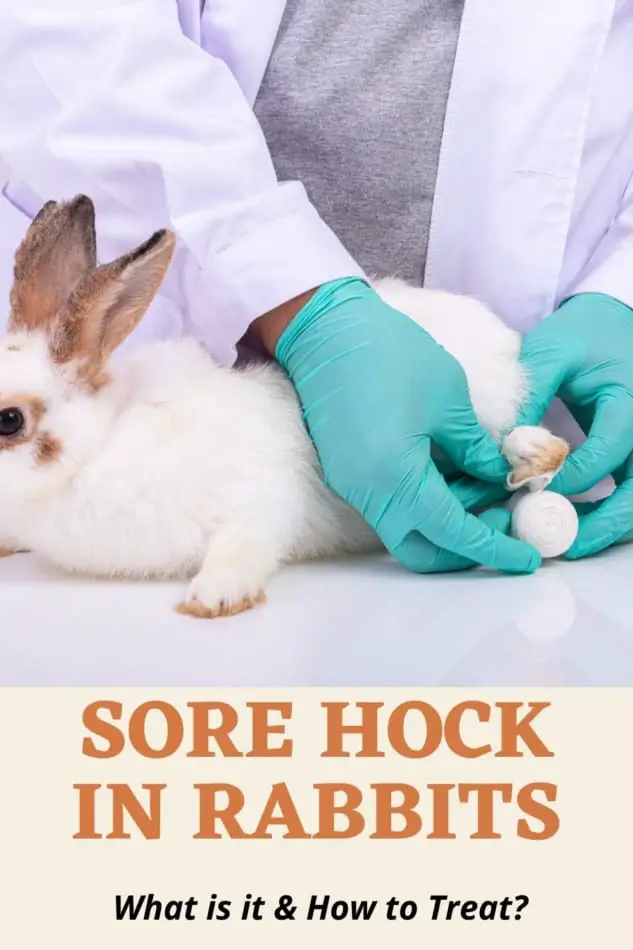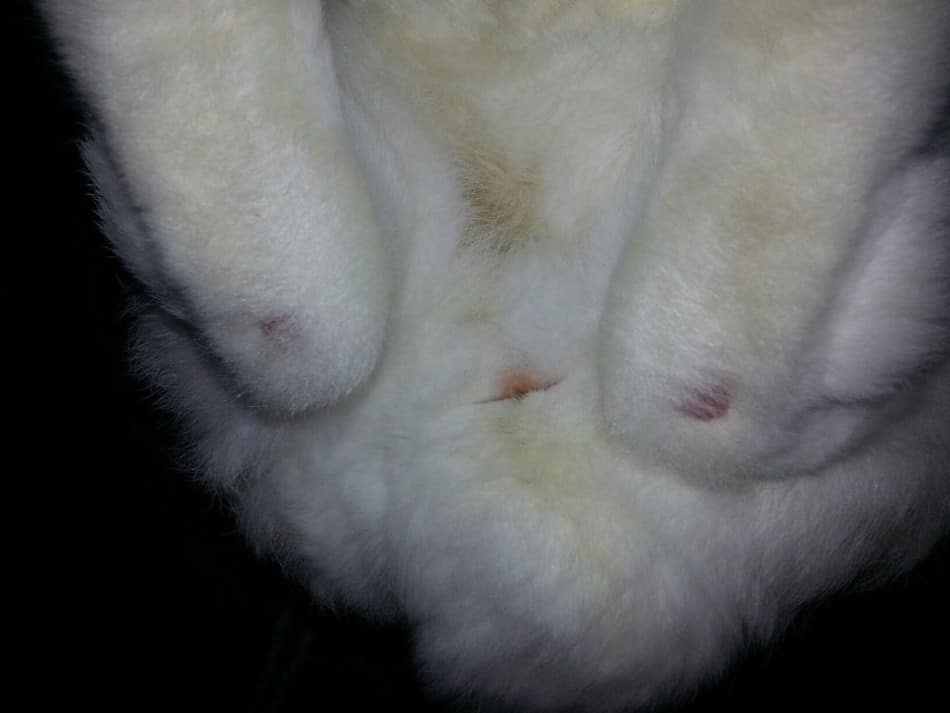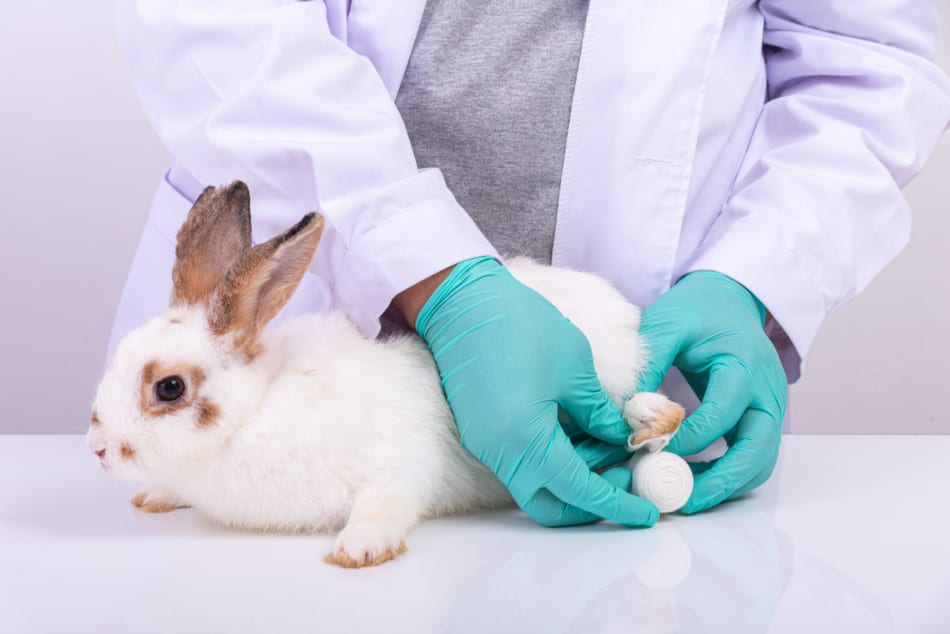All rabbit owners want to provide their pets with the best possible environment to live in. Happy bunny, happy owner right? But sometimes owners, especially if inexperienced can unwittingly harm their rabbits which can lead to some painful ailments like Sore Hock in Rabbits.
Sore Hock in rabbits: This is a condition that, in rabbits, is fairly common. This is an ailment that causes pain, discomfort, and infection in the legs and feet, earning it its name. Usually, rabbits develop Sore Hock from an environment that is unhygienic or uncomfortable. Fortunately, there are some simple things you can do to decrease the risk!

Table of Contents
Symptoms of Sore Hock
The symptoms of sore hock are simple and clear. To aid your rabbit in making the best recovery, keep an eye out, and catch these symptoms early on.
The first symptom of sore hock is a raw and inflamed sole. Your rabbit may limp or generally seem to feel discomfort or pain.
When left untreated, these symptoms will progress to infection, which can then spread to other tissues, including bone. You can see why you would want to catch this quick! This is normally a common and easy-to-treat condition, but if left alone, it can become fatal.
Should your rabbit show any signs of illness, sore hock or otherwise, seek prompt veterinary care! Some causes are not obvious, and some issues have progressed farther than we realize. Your vet will have the answer, and the cure!

Causes of Sore Hock
Sore Hock is Often Cause By The Wrong Enclosure Floor. Wire mesh or rough concrete,wooden bases.
Rabbit feet are extremely sensitive. In the wild, they are used to a ground of soft dirt, springy grass, or leaves, in a forest or meadow. This provides them with the proper support, cushion, and traction to dig, hop, run, and so on.
In a cage or enclosure, the flooring is usually made of wood, plastic, or metal. This is not nearly as ideal.
Wooden Hutches
In a wooden cage, your rabbit will have the support that they require. The traction is also okay. However, wood does not do much to provide cushioning by itself.
Plastic Cages
Plastic floors are much the same, offering a hard, unforgiving surface. Not only this, but they have so little friction that they can even be slippery! However, the worst kind of flooring for rabbits of all is metal.
Wire Mesh
Specifically, metal mesh. This tends to sag and is full of holes, and the solid parts provide no cushioning or traction, really. As a result, your rabbit will not have anywhere stable to stand, hop, or relax.
All of these flooring materials will put extra strain on the legs and feet of your rabbit, which can result in sore hock. You can use a grass or cotton mat to make almost any floor comfortable for your bun.
Line the floor with one of these, top it off with some bedding, and you can create a ground much like the one rabbits have naturally: springy, cushioned, easy to grip, and so on.
Obesity Will Increase The Chances of Sore Hock
Wild rabbits spend most of their time grazing, grooming, mating, and playing. In other words, they are quite active! This means that your domesticated rabbit should get plenty of exercise as well.
Without it, not only will they be unhappy, but they will also become prone to obesity, a condition that puts most animals at great risk. As a result, they can experience heart problems, breathing troubles, blood sugar problems (such as diabetes), and more.
Obesity can also cause rabbits to suffer from Sore Hock. The additional weight puts extra pressure on their feet so that they experience inflammation, fur loss, and the like.
This is one of the many reasons that you will want to resolve the obesity of your rabbit as quickly as possible. The sooner they are back to a healthy weight, the less damage overall that will be done.
The best exercise is to let your rabbit out of the cage to explore. There is not a whole lot that they can do in the limited space of an enclosure. You can grant them more room for movement with a multi-level cage or hutch as well.

Insufficient Foot Fur Is A Major Cause of Sore Hock
The fur on rabbit feet is not just for warmth, but for padding as well! Without enough fur on their feet, your rabbit will become much exponentially more likely to develop Sore Hock.
There are several things that can cause your rabbit to lose their protective foot fur, including mange, contact allergies, mesh wire flooring, obesity, etc.
Should you notice that your rabbit has thin fur on their feet, you should probably find out why. This can be a sign of other unpleasant conditions, as well as Sore Hock.
Many will also make their rabbit little booties, to protect their feet until the fur can grow back.
Untrimmed Nails Can Cause Sore Hock
When rabbit nails are allowed to grow too long, they can interfere with their posture. This can cause back problems and general body discomfort, along with Sore Hock. Your rabbit may even get their nails torn or stuck.
Luckily, you can avoid this entire situation pretty simply! All that you need to do is clip your rabbit’s nails every once in a while.
Recommended is every 6-8 weeks on average. However, you will still need to keep an eye on the nails of your individual bun (and trim them more frequently if necessary).
Unsanitary Cage Will Cause Sore Hock
A dirty cage is virtually guaranteed to cause sore hock. Sitting in droppings or urine will cause your rabbit’s feet to become raw. Infections can also develop quickly, especially if your rabbit has an abrasion or the like.
The Sore Hock will only get worse from here (not to mention the myriad of other health risks this will pose).
In an unhygienic cage, your rabbit is almost sure to contract Sore Hock, and in this environment, they will never get a chance to heal.
Fortunately, you can avoid this scenario altogether. Just make sure to keep your rabbit cage tidy. For example, spot-clean the rabbit cage or hutch once daily. You will also want to clean the litter box.
Sanitize the cage or hutch at least one time, but ideally a couple of times, a week. Ensure that their water and food are fresh.
Along with this, your rabbit will need adequate ventilation and airflow. To this end, you will need mesh walls, barred windows, or the like.
Small Cage Will Cause Sore Hock
In a small cage, your rabbit will not be able to stand comfortably or be particularly mobile. This will leave them susceptible to Sore Hock.
Your bun should be able to make at least three consecutive hops in their enclosure. This usually calls for a cage or hutch about 4 times their size in space or more.
The more time your rabbit spends in their cage, the more space they will need in their home.
Some Rabbit Breeds Are More Prone To Sore Hock
There are certain breeds that are more prone to Sore Hock. Two of the best-known are the Flemish Giant Rabbit and the Rex.
Flemish Giant Rabbits weigh 12-20 pounds, which means that, for a bun, they are extremely heavy. This puts all the more weight on their feet. For the Flemish Giant Rabbit especially, the proper flooring is essential.
Flemish Giant Rabbits also need their nails clipped more regularly than a smaller bun (perhaps every couple of weeks or so).
The Rex Rabbit is unique in a different way: they are your average size, but their fur is very thin. As a result, they have less natural padding or protection from Sore Hock.
Wrapping Up: Sore hock in rabbits
So, as you can see, there are several things that can put your rabbit at risk for Sore Hock. Your rabbit will most likely experience the condition at least once in their lifetime.
Fortunately, the condition is very possible to treat and cure! All that you need to do is change their environment accordingly, and get prompt veterinary care.
Rabbit Care Products








